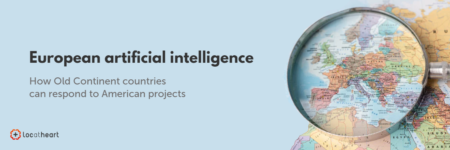ChatGPT vs humans: Assessing the role of AI in business
We’re at a dawn of a new era – the era of artificial intelligence. The end of 2022 saw the release of OpenAI’s ChatGPT which now boasts about 25 million daily users. While some of them are simply playing with the technology, asking it funny questions and waiting for even funnier answers, others – for example businesspeople – are utilising the AI-powered tool to streamline work processes and improve efficiency, freeing up precious time and resources.
Given the rapid development of ChatGPT, people around the world have found themselves wondering if the bot will take their jobs and proclaim, “Anything you can be, I can be greater. Sooner or later, I’m greater than you!” Are their worries justified, though? Is ChatGPT designed to fully automate tasks previously performed by people, or will it be used to enhance and complement human efforts?
Create and summarise, but not translate
During a buy-side panel discussion at the Chat GPT in Localization conference, Bea Verdasco (Head of Localisation at Trendyol), Jose Palomares (Localisation Director at Coupa) and Anna Golubeva (Localisation Manager at IKEA) shared their insights on how to effectively leverage generative AI while also mitigating potential drawbacks.
Palomares tested various applications of ChatGPT with his team, using it, for instance, to generate content related to financial management software. The results were mixed, indicating that the technology may not yet be suitable for highly specialised writing. Palomares notes, however, that ChatGPT does well when it comes to simplifying and summarising material filled with industry-specific jargon, which can be helpful in writing request for proposal documents for potential clients.
On top of that, ChatGPT excels at text copy post-processing, including spelling correction and proofreading. The bot’s advanced language processing capabilities make it an effective tool for ensuring that documents are error-free and convey the intended message.
Palomares also tested ChatGPT’s ideation feature and found that it is particularly skilled at generating writing prompts. It can be trained on specific writing styles, such as marketing language or creative writing, and can generate multiple outputs to choose from. The ideation feature can be a useful tool for content creation or brainstorming sessions.
Although ChatGPT excels in generating English content from scratch, , it performs poorly in the area of translation and localisation,struggling with delivering high-quality target texts and making basic mistakes.
Flawless business communication
As AI continues to advance, it offers great potential for bridging the communication gap between people who speak different languages, enabling them to communicate more effectively and accurately.
Verdasco, who works at Türkiye-based Trendyol, adds that ChatGPT can be an incredibly useful tool for companies whose employees don’t speak English as their first language. The bot can aid in English communications and the polishing of professional emails, client-facing documents and other types of business writing.
With the help of ChatGPT, non-native English speakers can communicate more effectively, without having to worry about grammatical or spelling errors. This can lead to more successful interactions with clients, as well as enhanced business communication in general. Additionally, the tool can assist with tone, ensuring that messages are delivered appropriately for the intended audience. While ChatGPT is a powerful language model, it’s also worth exploring other AI tools available on the market that offer unique capabilities and advantages. As Verdasco reveals, her company is branching outside of OpenAI’s world-famous solution and looking for other tools that would help optimise their processes and expand their localisation efforts, including the areas of subtitling, transcription, video editing and generated voiceover.
Lightning-fast responses
Answering translation queries can be very time-consuming for coordinators managing several multilingual projects at a time. It can slow down project timelines and even lead to errors in the final product, which is why many companies are looking for ways to automate this process.
Golubeva states that a potential use-case for ChatGPT is to have the bot answer translator queries. Industry giants such as IKEA have to manage a significant amount of content and internal documentation – a chatbot powered by ChatGPT, hooked up to the internal database, could dispel any doubts without undue delay. This would help streamline the translation process and improve overall efficiency, as the chatbot could handle routine questions, while directing more complex ones to the in-house team. Ultimately, this kind of approach could save time and reduce the workload of a wide group of people, while also ensuring that all queries are addressed in a timely and accurate manner.
Other businesses – especially huge retailers – striving to provide 24/7 customer support, have turned to AI-powered virtual assistants which handle customer queries and complaints. From chatbots to voice assistants, these technologies have become increasingly common in various industries, allowing companies to answer a large volume of customers’ messages around the clock, without the need for human agents.
Human in the loop
When it comes to ChatGPT, one must keep in mind that the involvement of human input is crucial for ensuring quality output. Rather than relying on AI as an all-in-one solution, it’s more beneficial to train writers to use AI tools and text generation effectively. There’s also the issue of privacy, particularly regarding sensitive and unreleased data. One major obstacle to the scalability of generative AI models is their lack of control, as they’re currently struggling to provide reliable and consistent content.
There’s a clear conclusion to draw from the discussion among the experts: to fully integrate Large Language Models into their workflows, companies need to see specific and well-developed use-cases that demonstrate the tool’s value and potential benefits. Ultimately, AI tools have enormouspotential for improving productivity, however, they must be used responsibly and with careful consideration of their limitations and risks.
Source:
Custom.MT, ChatGPT in Localization. „Buy-side panel: Applying ChatGPT in Localization.” Moderator: Stacey Lisina. Online event, 1 March 2023: https://www.youtube.com/watch?v=jM91CdLXuog





![Customer self-service in the digital age [featured image] - translation agency LocAtHeart](https://locatheart.com/wp-content/uploads/2021/11/1-450x231.png)
Leave a Reply